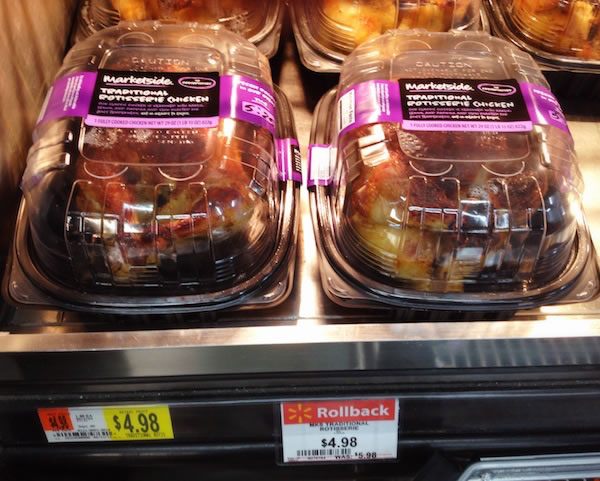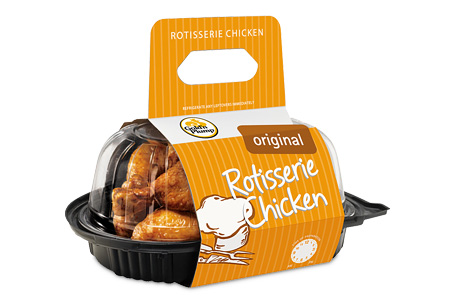In “I have NO ONE to love!”, my recent post on the heartbroken guy at the grocery store near me on Valentine’s Day, I mentioned that the two items in his cart were a six-pack of beer and a store-bought rotisserie chicken. I linked to a Bloomberg article by Megan McArdle titled Everyone Wins When You Buy a Rotisserie Chicken, in which she links to Cat Vasko’s article for KCET, Grocery Store Economics: Why are Rotisserie Chickens So Cheap?, which sets out to answer its titular question.
Enough readers told me that they were surprised by the facts about these tasty bundles of joy that I decided the grocery store rotisserie chicken deserved its own blog entry.

Vasko’s answer to the mystery of why fully-prepped store-bought chicken is cheaper than buying a raw chicken and then putting in the time to cooking it can be summed in a single word: economics. Here’s how she explains it:
…much like hunters who strive to use every part of the animal, grocery stores attempt to sell every modicum of fresh food they stock. Produce past its prime is chopped up for the salad bar; meat that’s overdue for sale is cooked up and sold hot. Some mega-grocers like Costco have dedicated rotisserie chicken programs, but employees report that standard supermarkets routinely pop unsold chickens from the butcher into the ol’ rotisserie oven.
…
Rotisserie chickens aren’t even the end of the line. When unsold, fresh meats, fruits and veggies that have passed their sell-by points can be “cooked up for in-store deli and salad counters before they spoil,” per no less a source than a consultant to the supermarket industry.

At this point, you might be concerned that the chickens are cheap because you’re buying rotten food. That’s not the case. The datestamps you see on food products, often called the “sell-by”, “use-by”, and “best before” dates, aren’t safety indicators, but a general ballpark figure to give you a hint of when the food will be at its best. The sell-by date is often based on how long it takes for the product to change noticeably in appearance — not its safety — when stored properly. That’s why most of the time, food that’s a few days or more past its sell-by date won’t make you ill or kill you. In fact, sell-by dates are scaring people into throwing perfectly good food away.
In the end, your own good sense and education (or, if need be, a friend or family member’s good sense and education) is your best guide. You can augment your good sense and education at StillTasty.com. If you want to get the most bang for your grocery buck, bookmark this site!

In a world where buying something at a ridiculously cheap price means that something bad happened, the grocery store rotisserie chicken is a shining beacon of virtue. You get a cheap dinner, the grocery store wastes less food, the grocery store can sell fresh raw food at lower prices — everybody wins, except for the chicken!
I love what McArdle has to say about the importance of the store-prepped chicken:
This is the sort of thing that no one talks about when they talk about innovation –and yet, it’s a major way in which our economy has become more efficient over the last few decades. Reducing spoilage means grocery stores can sell us raw chickens at lower prices — and that we can get fresh, delicious prepared food at even lower prices. It’s a win for the grocer and the consumer.
So the next time you hear someone talk about the innovation economy, don’t just think of Facebook or Google. The folks who spit-roast chickens, streamline factory production, or think up any of a million ways to save a little money here and there are just as important in improving our standard of living. Especially when it’s five minutes to 7 and you still haven’t made anything for dinner.
(And in my opinion, it’s the chicken’s own damn fault. As an omnivore, I’ve always said that if animals don’t want to be eaten, they should vote.)

When the conversation topic turns to store-bought rotisserie chicken — it happens more often than you think, at least in the circles in which I move — the ones you can get at Costco eventually come up. At the time of this writing, the price of a tasty, roasted whole bird is still $4.99, which is less than most combos at a food court. When they reported some disappointing financial results (not big losses, but tiny gains) back in 2013, Costco’s CFO urged investors to think of their “incredible, giant” rotisserie chickens when they thought of Costco, and their stock price bounced back quickly. The birds get discussed by the foodies on Chow, covered in pieces in the Washington Post, and debated over in bodybuilding forums (“Emergency muscle food, brah!“). Costco maintains a Facebook page for their rotisserie chickens, and you can easily find fans on Pinterest.

While rotisserie chickens are great as-is, they’re also excellent starters for your own recipes, and since they’ve already been cooked, you’ll save time. Since I work from home and The Missus commutes, I’m usually on the hook for making dinner, so I’ve picked up a collection of go-to places for all sorts of meals. Here are mine for store-bought rotisserie chicken:
- The Art of Manliness’ 5 Delicious Ways to Use a Store-Bought Rotisserie Chicken
- U Create’s Best Rotisserie Chicken Recipes. Try the chicken enchilada soup!
- Cookies and Cups’ 50 Shortcut Meals Using Rotisserie Chicken.
- Real Simple’s 10 Recipe Ideas for Rotisserie Chicken
- Food Network’s Weeknight Rotisserie Chicken Recipes
